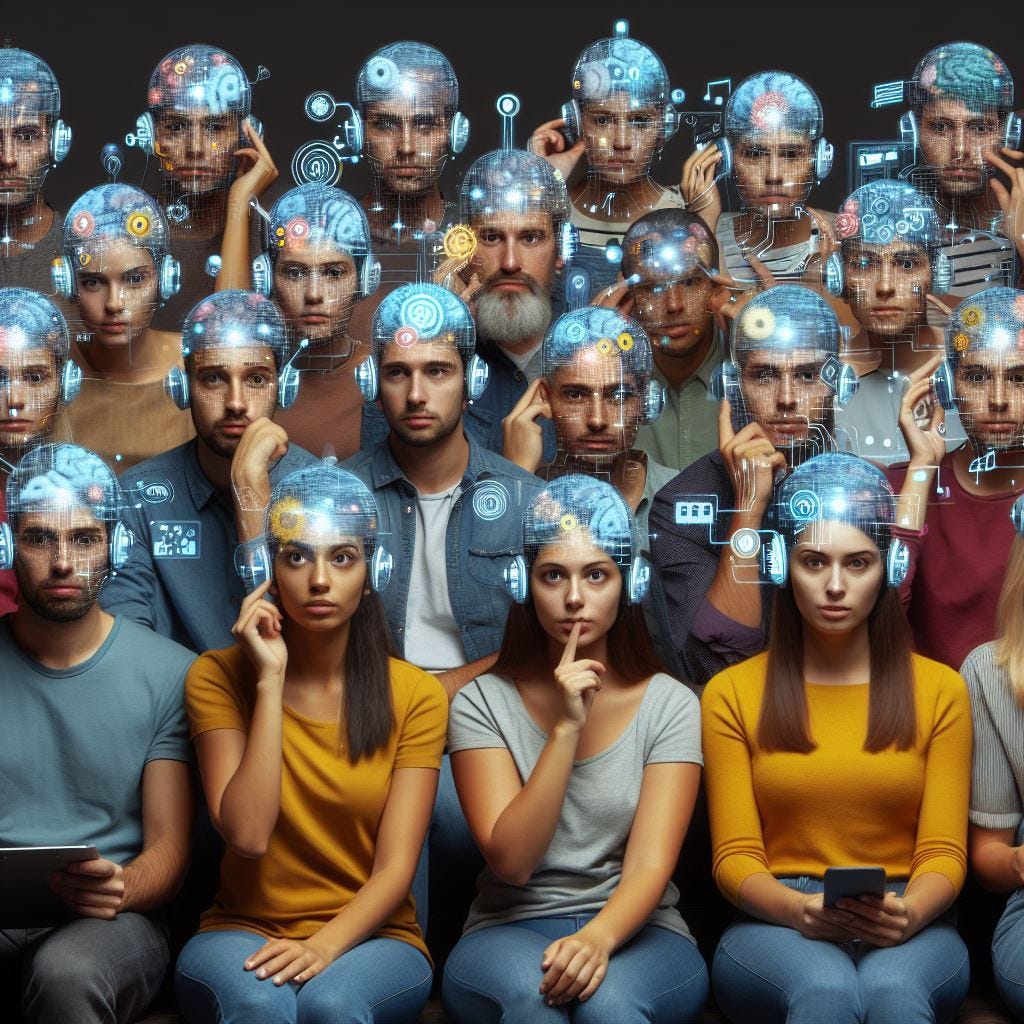My Brain is your Brain and your Brain is mine
Description
My latest piece for german expert platform Piqd, a piece that summarizes latest developments in BCI-technology and extrapolates some possible future scenarios in context of Neuro-Ethics. I translated the thing with ChatGPT and edited for kicks, below the piece in its original german language.
GOOD INTERNET is a reader supported online mag. If you like what i do here, you can support this thing by upgrading your subscription to a paid plan or use one of the other support options you can find at the bottom of this issue.

english
A brief History of Neurotech
Musk recently claimed on his X-formerly-known-as-Twitter that his BCI company, Neuralink has implanted the "first" "chip" in a test subject, who reportedly is doing well post-surgery. In another tweet, Musk claimed the patient successfully "moved a mouse" — referring to maneuvering a cursor on a screen. Musk and Neuralink's stated goal: "Imagine if Stephen Hawking could communicate faster than a speed typist or auctioneer." However, there's no evidence supporting Musk's claims, and the newsworthiness of his announcements is close to zilch because:
Putting aside the fact that Musk himself is the sole source of these assertions, these supposed advancements in brain-computer interface (BCI) technology are old news. As noted by renowned neuroscientist Anil Seth in his Guardian article questioning whether we should all be getting chips in our heads, Neuralink is a newcomer to the field, and thought-controlled cursors on screens have been around since the 90s. The actual innovation from Musk's company, an operation robot deploying brain implants, remains shrouded in mystery amid these recent announcements, prompting concerns from neuroscientists.
The reason Elon Musk is working on BCI tech with Neuralink is a nobrainer: the technology, with or without Musk, is advancing rapidly, and an automated implantation machine with BCI and OP robot spells massive profit. In just the past 12 months, neuroscientists, aided by artificial intelligence, have achieved remarkable feats: enabling a paralyzed man to walk again; allowing another paralyzed patient to use their arms and feel with their hands, restoring speech to a woman paralyzed after a stroke at a “brain-to-text rate of 78 words per minute”; reconstructing music from brain activity; and reconstructing images from visual cortex activity. And in previous years, digital "telepathy" has been made possible, aswell as linking the brains of three patients into a network.
Psychologist Gary Lupyan and philosopher Andy Clark have expressed skepticism in an essay on Aeon about direct digital "telepathy," essentially because neural activity is too idiosyncratic and individual to reliably transfer from one person to another. However, they overlook the potential for AI technology to serve as an interpreter between the different neuropatterns of participants. But this (hopefully) is still ways off because, beyond the superficial sci-fi “coolness” of digital "telepathy," there's the question of whether anyone really wants a direct line to other people's thoughts, with all their invasive thoughts and all the neuro-chaos that comes with the package, or how one could technically prevent access to supposedly "Private Thoughts." Maybe I'd rather not know what my neighbor really thinks about me — and vice versa.
Anil Seth also raises the important question in the aforementioned text of whether people will really want to open their skulls to such neuro-antics just to read the chaotic thoughts of their similarly brain-implanted neighbors or to get a few cognitive prostheses. His answer: No. However, an invasive operation might not even be necessary in the future.
In December of last year, researchers at the University of Sydney unveiled a non-invasive brain scanner worn by patients as a simple EEG "cap." While its signal is noisier, the experiment achieved state-of-the-art performance for brain-to-text outputs, albeit with a relatively high error rate. Nonetheless, it's expected that these non-invasive technologies will also make rapid progress, and there are already early hints of their application in future mass markets: last summer, Apple filed a patent for EEG AirPods, in-ear headphones capable of reading electrical signals from the brain. You don't have to be a sci-fi nerd anymore to envision the next generations of Apple's VR/AR glasses with brain interfaces.
All these massive advancements in BCI technology underscore the need for a broad public debate on the ethics of brain interfaces. Already, there are thousands of cases of patients with brain implants left unsupported after a startup's demise, with outdated code and dead batteries in their heads, and Technology Review reports the case of Rita Leggett, a patient with severe epilepsy who was able to lead a nearly normal life thanks to a novel implant that had to be removed after the company went bust — potentially violating her human rights.
In July 2023, UNESCO organized the first conference on neuroethics, calling for a framework for human rights in the context of neurotechnologies and discussing the concept of neuro-rights. Chile became the first country in the world in 2021 to amend its constitution to include explicit rights for neuro-privacy.
Before, the scientific discourse on neuroethics has been ongoing for decades, with the International Neuroethics Society being founded in 2006. The papers "On Neurorights" from 2021 and the paper "<a href="https://www.mdpi.com/2409-9287/5/4/31"





